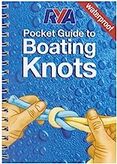|
There are particular ways to tie a line to a cleat, to stow and unstow lines and to leave working lines on a winch or in a bag. I haven't mentioned these methods here because every video I have seen on the subject on youtube has been incorrect or doesn't work for large lines (like the ones on 70ft Clipper boats).
Your Clipper training team will teach you these things during level 1 training. |
|
BOWLINE
THE most used knot by crew. You need to be able to tie this with cold hands, at night with your eyes closed. One-handed is quite possible. Basically, you need to be confident you can tie this knot!
|
CLOVE HITCH
A handy knot and useful for tying fenders onto stancion posts and guard wire. When tied so as to be quick release it is handy when coming alongside, making fenders quickly transferable.
|
ROUND TURN & 2 HITCHES
A much better long term knot for fenders. Tying this knot around the base of stanchion posts makes for a secure, longterm solution that will secure your fenders in the choppiest marina.
|
|
ADMIRALTY STOPPER KNOT
This is referred to as 'the admiralty stopper' knot and it is used on clipper boats. Use the knot on the ends of halyards and sheets (NEVER on spinaker halyards or sheets though). On big boats wind around your hand, not finger and leave about 18 inches of tail. 3 turns is enough.
|
ROLLING HITCH
A very useful knot indeed. Used regularly to take load off one line with another. If you can tie a bowline and rolling hitch reliably, you are useful crew. On larger boats more turns are used to make the knot more effective.
|
Useful to know if you sail
|
TRUCKER'S HITCH
A useful knot used to tidy halyards at the mast. Useful to know but not widely used on Clipper boats.
|
COW HITCH
The cowhitch is used regularly at sea. It is a handy way to secure line not in use, but at the same time making it simple to get at when needed. Some skippers use a cowhitch for securing spinaker sheets but there are more secure alternatives.
|
FIGURE EIGHT STOPPER
You need to know this for your RYA competent crew certificate (and part of L1 Training). Probably one of the most pointless knots you'll learn. Hopeless as a stopper, but the RYA say you should know how to tie it.
|
|
REEF KNOT
The reef knot is needed for RYA Comp Crew but, again, it has little benefit in the real world. I don't think I have ever used a reef knot whilst sailing...
|
COMMON WHIPPING
There are better whippings but this'll do as a stop-gap solution to a fraid line that needs tidying.
|
HOW TO FLAKE A LINE
Flaking out line runs makes rigging the boat easier as line doesn't bind and get stuck. When preparing a halyard to run it should be flaked too. Using a winch to flake around makes it easier. Ask your mate how.
|
Tugman's Hitch (Lighterman's Hitch) for securing a mooring line to a winch)
This is a method of securing a mooring line to a midship's winch without using the self-tailing mechanism which is not designed for a mooring warp. The self-tailer will be overstressed and break. Instead, use 3 or 4 turns on the winch (clockwise) and pull tight, then tie the knot.
fierceturtle.co.uk |
PRIVACY & GDPR POLICIES
© COPYRIGHT 2012-23. ALL RIGHTS RESERVED. 256 bit secure checkout powered by stripe. |
